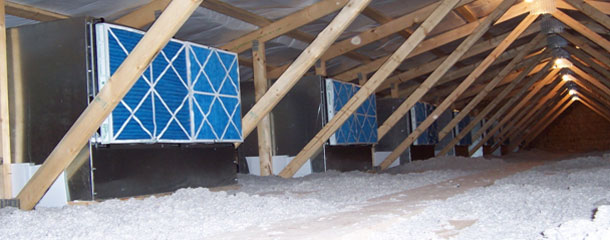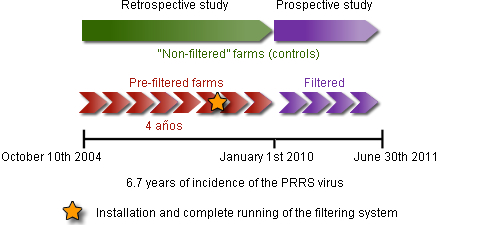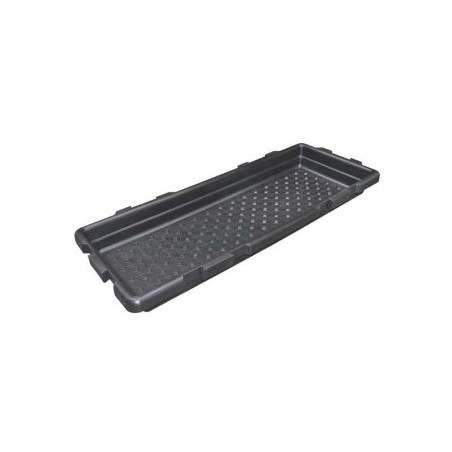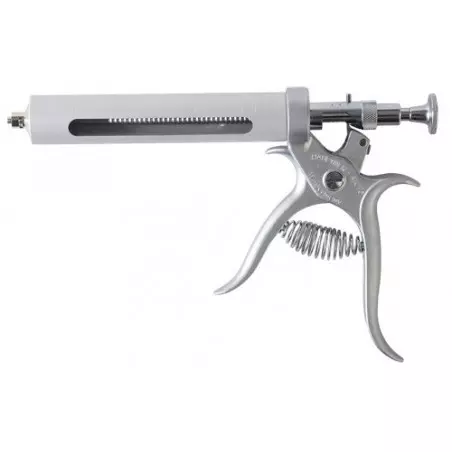In spite of the proven success of the different control and eradication strategies against the porcine reproductive and respiratory syndrome virus (PRRS), this disease still causes enormous losses in the North American swine sector. Sows' farms with a correct biosafety but with an important record of windborne reinfections due to new PRRS virus strains have chosen the adaptation of their production system towards the air filtering. Nowadays, more than 200,000 sows produce in farms with an air filtering system in the area located in the south of Minnesota and the north of Iowa, and the expectations are that these numbers carry on growing.


Image of the attic with filter boxes in a sows' farm adapted to the air filtering system.
Different studies have proved the success of this system. Nevertheless, due to the high financial investment that this system entails, there is the need of analyzing, in great detail, this biosafety measure in the long term in order to evaluate, subsequently, its financial return. Two articles in this section will explain the performance results in these farms from the epidemiological and the production/financial point of view in comparison with the non-filtering farms (controls).
The longitudinal study included the records of new PRRS virus outbreaks in 20 "filtered" farms (before and after applying the filtering system). All the farms that took part in the study had to have some common features: a census of more than 2,400 sows, they had to be advised by 3 important veterinary clinics, they had to be surrounded by 3 or more pig farms, they had to have a similar biosafety level that had to be certified by their veterinarians, they had to have a surveillance system against the PRRS virus based on monthly veterinary visits and serology/PCR of batches of weaned animals, and the filtering system had to be working all year long.
All the farms were included in the study in January 2010 and their monitoring was carried out until June 30th 2011. The control farms (with a total of 58,900 sows) were monitored from October 2004 until June 2011 (6.75 years). The "filtered" farms (63,600 sows), on the other hand, were monitored for 4 years before the installation of the filtering system and, once they had installed it, until June 2011, with a mean of 1.6 years per farm (range: 0.49 - 2.47 years) (Graph 1).

Graph 1: Study Design
- Control farms: Group of farms of the study whose role was to control and assess the risk in the area against the PRRS virus during the study (mean study time: 6.7 years/farm).
- Pre-filtered farms: Filtered farms before the installation of the filters system (mean study time: 4 years/farm).
- Filtered farms: State of the farms after the installation of the filters (mean study time: 1.6 years/farm).
In order to analyze the incidence of the PRRSV outbreaks, we studied the complete dendograms of these farms, in which the sequences of the genes that make up the ORF5 of all the PRRS viruses isolated during the surveillance programs are represented. The introduction of a new virus in the farm that would have caused a supposed outbreak of PRRS (due to the lack of crossed protection against different strains of this virus) was defined for the study as the detection of a new isolation in the dendogram with a difference in the percentage of the nucleotids ≥5%.
After the analysis of the information of the dendograms of all the farms, and bearing in mind the analysis time of the study (time under risk), the incidences of the outbreaks and their frequency in the filtered farms and the control farms were calculated before and after the installation and the full operation of the filters. Table 1 summarizes the results of the analysis.
Table 1. Time during which the farms are under risk, number of cases identified in the dendograms, and mean time between outbreaks in the 3 groups of periods of filtered farms before and after being filtered and in control farms. Summary of the results.
| Number of farms | Mean of years under risk/farm | Total years under risk (sum of all the farms) | Number of PRRS outbreaks | Incidence of outbreaks / 10 years under risk | Mean of months between outbreaks | Mean of years between outbreaks | |
| Control | 17 | 7.1 | 121.2 | 52 | 4.29 | 28.0 | 2.3 |
| Pre-filtered | 20 | 4.2 | 83.3 | 60 | 7.20 | 16.7 | 1.4 |
| Filtered | 20 | 1.6 | 31.5 | 4 | 1.27 | 94.5 | 7.9 |
Taking as a reference the incidence seen in Table 1, we calculate the relative risk (RR) of the filtered farms when comparing them with their own records with respect to the PRRS virus before being filtered and the attributable risk (AR) towards the airborne transmission of the virus.
- RR pre-filtered/filtered = 7.20 / 1.27 = 5.66
- Under the conditions of the study, the farms with an air filtering system reduced in 5.6 points the risk with respect to new introductions of PRRS viruses when comparing them with non-filtered farms.
-
AR airborne transmission of the virus = [(7.2 - 1.27)] / 7.2 = 0.82 = 82%
Approximately an 82% of the outbreaks in the non-filtered farms were attributable to the airborne transmission of the virus or, in other words, an 82% of the outbreaks could be avoided with the installation of filters.
The results and the conclusions of this study are summarized in the following items:
- The air filtering reduced the risk of new introductions of PRRS virus in the farms when comparing them with the non-filtered control farms.
- Control farms presented a lower risk against the PRRS virus than those farms that decided, voluntarily, to adapt their system to the filtering of the air.
- The 82% of the PRRS virus outbreaks suffered by the non-filtered farms could be avoided with the installation of the air filters.









